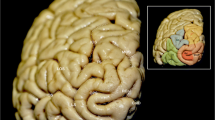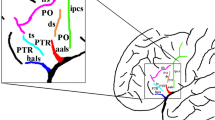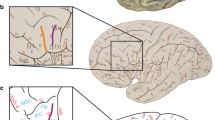Abstract
The external morphology of the occipital lobe was investigated in 15 human post-mortem brains (30 hemispheres) fixed in formalin. We identified, described and measured the lengths of nine major human occipital sulci and five variable ones, comparing both types between individuals and hemispheres. Morphological variability of human occipital sulci is related to interindividual and interhemispheric differences in their presence, origin, type, segmentation, intersection and length. The major occipital sulci, particularly the parieto-occipital, the calcarine, the inferior lateral occipital and the anterior occipital sulci, as well as two points of their intersections (cuneal point and intersection of the transverse occipital and superior occipital sulcus) may be used as reliable anatomical landmarks for the location of architectonically and functionally defined human visual areas (V1, V2, V3, V3A, V5/MT+, LO1 and LO2) and during less invasive neurosurgical procedures in the cases of focal lesions within the occipital lobe. Two lateral occipital sulci (inferior and superior) were defined on the lateral surface of the occipital lobe. The variable lunate sulcus was studied and combining our results with those from histological and functional imaging studies, we suggest that the lunate sulci of human and nonhuman primates are not homologous.



Similar content being viewed by others
Abbreviations
- Acc1:
-
Accessory sulcus associated with the superior occipital sulcus
- Acc2:
-
Accessory sulcus of the occipital pole
- Acc3:
-
Accessory sulcus associated with the collateral sulcus
- Acc4:
-
Accessory sulcus associated with the inferior lateral occipital sulcus
- AOS:
-
Anterior occipital sulcus
- CaS:
-
Calcarine sulcus
- CaS-a:
-
Anterior part of the calcarine sulcus
- CaS-m:
-
Middle part of the calcarine sulcus
- CaS-p:
-
Posterior part of the calcarine sulcus (retrocalcarine sulcus)
- CoS:
-
Collateral sulcus
- ILOS:
-
Inferior lateral occipital sulcus
- IOS:
-
Inferior occipital sulcus
- IPS:
-
Intraparietal sulcus
- ITS:
-
Inferior temporal sulcus
- LiS:
-
Lingual sulcus
- LOTS:
-
Lateral occipito-temporal sulcus
- LuS:
-
Lunate sulcus
- OpS:
-
Occipitopolar sulcus
- PCaS:
-
Paracalcarine sulci
- PI:
-
Pre-occipital incisure
- POS:
-
Parieto-occipital sulcus
- SLOS:
-
Superior lateral occipital sulcus
- SOS:
-
Superior occipital sulcus
- STS:
-
Superior temporal sulcus
- TOS:
-
Transverse occipital sulcus
- +:
-
Gyrus descendens
References
Allen JS, Bruss J, Damasio H (2006) Looking for the lunate sulcus: a magnetic resonance imaging study in modern humans. Anat Rec Part A 288:867–876
Amunts K, Malikovic A, Mohlberg H, Schormann T, Zilles K (2000) Brodmann’s areas 17 and 18 brought into stereotaxic space—where and how variable? Neuroimage 11:66–84
Annese J, Gazzaniga MS, Toga AW (2005) Localization of the human cortical visual area MT based on computer aided histological analysis. Cereb Cortex 15:1044–1053
Bouvier SE, Engel SA (2006) Behavioral deficits and cortical damage loci in cerebral achromatopsia. Cereb Cortex 16:183–191
Brodmann K (1909) Vergleichende Lokalisationslehre der Grosshirnrinde in ihren Prinzipien dargestellt auf Grund des Zellenbaues. Barth JA, Leipzig
De Yoe EA, Carman GJ, Bandettini P, Glickman S, Wieser J, Cox R et al (1996) Mapping striate and extrastriate visual areas in human. Proc Natl Acad Sci USA 93:2382–2386
Dumoulin SO, Bittar RG, Kabani NJ, Baker CL Jr, Le Goualher G, Pike GB et al (2000) A new anatomical landmark for reliable identification of human area V5/MT: a quantitative analysis of sulcal patterning. Cereb Cortex 10:454–463
Duvernoy HM (1999) The Human Brain. Springer, Vienna
Economo C, Koskinas GN (1925) Die Cytoarchitektonik der Hirnrinde des erwachsenen Menschen. Springer, Vienna
Elliot Smith G (1907) A new topographical survey of the human cerebral cortex, being an account of the distribution of the anatomically distinct cortical areas and their relationship to the cerebral sulci. J Anat Physiol 41:237–254
Filimonoff IN (1932) Uber die Variabilitat der Grosshirnrindenstruktur. Mitteilung II. Regio occipitalis beim erwachsenen Menschen. J Psychol Neurol 45:65–137
Hadjikhani N, Liu AK, Dale AM, Cavanagh P, Tootell RBH (1998) Retinotopy and color sensitivity in human visual cortical area V8. Nat Neurosci 1:235–241
Hasnian MK, Fox PT, Woldorff MG (2006) Hemispheric asymmetry of sulcus-function correspondence: quantization and developmental implications. Hum Brain Mapp 27:277–287
Hinds O, Polimeni JR, Rajendran N, Balasubramanian M, Amunts K, Zilles K et al (2009) Locating the functional and anatomical boundaries of human primary visual cortex. Neuroimage 46:915–922
Horton JC, Hoyt WF (1991) The representation of the visual field in human striate cortex: a revision of the classic Holmes map. Arch Ophthalmol (Copenhagen) 109:816–824
Huk AC, Dougherty RF, Heeger DJ (2002) Retinotopy and functional subdivision of human areas MT and MST. J Neurosci 22:7195–7205
Iaria G, Petrides M (2007) Occipital sulci of the human brain: variability and probability maps. J Comp Neurol 501:243–259
Kuhlenbeck H (1928) Bemerkungen zur Morphologie das Occipitallappens des menschlichen Grosshirns. Anat Anz 65:273–294
Larsson J, Heeger DJ (2006) Two retinotopic visual areas in human lateral occipital cortex. J Neurosci 26:13128–13142
Malikovic A, Amunts K, Schleicher A, Mohlberg H, Eickhoff SB, Wilms M et al (2007) Cytoarchitectonic analysis of the human extrastriate cortex in the region V5/MT+: a probabilistic, stereotaxic map of area hOc5. Cereb Cortex 17:562–574
McKeefy DJ, Zeki S (1997) The position and topography of the human colour centre as revealed by functional magnetic resonance imaging. Brain 120:2229–2242
Meadows JC (1974) Disturbed perception of colours associated with localized cerebral lesions. Brain 97:615–632
Meynert T (1877) Die Windungen der convexen Oberfläche des Vorder-Hirnes bei Menschen, Affen und Raubthieren. Arch Psychiat 7:257–286
Ono M, Kubik S, Abernathey CD (1990) Atlas of the cerebral sulci. Georg Thieme Verlag, Stuttgart
Retzius G (1896) Das Menschenhirn. Königliche Buchdruckerei PA Norstedt und Söner, Stockholm
Tootell RHB, Reppas JB, Kwong KK, Malach R, Born RT, Brady TJ et al (1995) Functional analysis of human MT and related visual cortical areas using magnetic resonance imaging. J Neurosci 15:3215–3230
Tootell RBH, Mendola JD, Hadjikhani NK, Ledden PJ, Liu AK, Reppas JB et al (1997) Functional analysis of V3A and related areas in human visual cortex. J Neurosci 17:7060–7078
Wandell BA, Dumoulin SO, Brewer AA (2007) Visual field maps in human cortex. Neuron 56:366–383
Watson JDG, Myers R, Frackowiak RSJ, Hajnal JV, Woods RP, Mazziota JC et al (1993) Area V5 of the human brain: evidence from a combined study using positron emission tomography and magnetic resonance imaging. Cereb Cortex 3:79–94
Wilms M, Eickhoff SB, Hömke L, Rottschy C, Kujovic M, Amunts K et al (2010) Comparison of functional and cytoarchitectonic maps of human visual areas V1, V2, V3d, V3v and V4(v). Neuroimage 49:1171–1179
Zeki (1991) Cerebral akinetopsia (visual motion blindness). Brain 114:811–824
Zihl J, Von Cramon D, Mai N (1983) Selective disturbance of movement vision after bilateral brain damage. Brain 106:313–340
Acknowledgments
This study was supported by Grant No. 175030 of the Ministry of Science and Technological Development, Republic of Serbia.
Conflict of interest statement
The authors declare that they have no conflict of interest.
Author information
Authors and Affiliations
Corresponding author
Rights and permissions
About this article
Cite this article
Malikovic, A., Vucetic, B., Milisavljevic, M. et al. Occipital sulci of the human brain: variability and morphometry. Anat Sci Int 87, 61–70 (2012). https://doi.org/10.1007/s12565-011-0118-6
Received:
Accepted:
Published:
Issue Date:
DOI: https://doi.org/10.1007/s12565-011-0118-6




